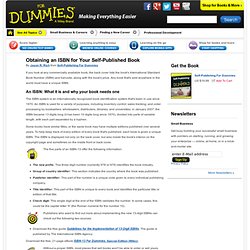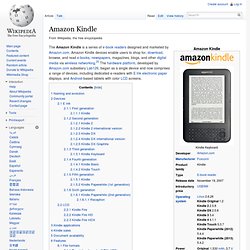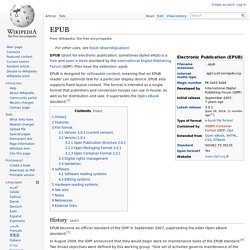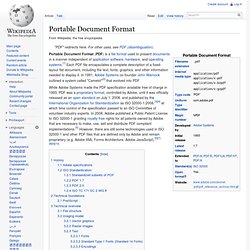

Obtaining an ISBN for Your Self-Published Book. If you look at any commercially available book, the back cover lists the book's International Standard Book Number (ISBN) and barcode, along with the book's price.

Any book that's sold anywhere in the world must have a unique ISBN. An ISBN: What it is and why your book needs one The ISBN system is an internationally recognized book identification system that's been in use since 1970. An ISBN is used for a variety of purposes, including inventory control; sales tracking; and order processing by booksellers, wholesalers, distributors, libraries, and universities. in January 2007, the ISBN became 13 digits long (it has been 10 digits long since 1970), divided into parts of variable length, with each part separated by a hyphen.
Some books have similar titles, or the same book may have multiple editions published over several years. The five parts of an ISBN-13 offer the following information: Download the free guide Guidelines for the Implementation of 13-Digit ISBNs. . • Mail: R.R. Blog. CreateSpace. InstantPublisher.
Go Publish Yourself. Blurb. Bookemon. FastPencil. Wordclay. Lulu. Smashwords - Ebooks from independent authors and publishers. Self-Publish with Us. KDP - Kindle Direct Publishing: Self-publish to Amazon's Kindle Store.
How to Self-Publish a Book. Self-Publishing Tutorial: The Top 10 Things You Should Know about Self-Publishing Your Book. How to Self-Publish a Book. E-Books and Self Publishing Part 1. KDP files and Amazon Kindle. Naming and evolution[edit] The Kindle name was devised by branding consultant Michael Cronan who was asked by Lab 126 to name the product.

Cronan and partner Karin Hibma suggested Kindle, meaning to light a fire.[3] They felt this was an apt metaphor for reading and intellectual excitement.[4] Kindle hardware has evolved from the original Kindle introduced in 2007 and a Kindle DX line (with a larger screen) introduced in 2009. The range now includes devices with a keyboard (Kindle Keyboard), devices with touch-sensitive screens (Kindle Paperwhite), a tablet computer with a reader app and a color display (Kindle Fire), and a low-priced model with an on-screen keyboard (Kindle).
In the last three months of 2010, Amazon announced that in the United States, their e-book sales had surpassed sales of paperback books for the first time.[10] EPUB. EPUB (short for electronic publication; sometimes styled ePub) is a free and open e-book standard by the International Digital Publishing Forum (IDPF).

Files have the extension .epub. EPUB is designed for reflowable content, meaning that an EPUB reader can optimize text for a particular display device. EPUB also supports fixed-layout content. The format is intended as a single format that publishers and conversion houses can use in-house, as well as for distribution and sale. It supersedes the Open eBook standard.[2] History[edit] EPUB became an official standard of the IDPF in September 2007, superseding the older Open eBook standard.[3] In August 2009, the IDPF announced that they would begin work on maintenance tasks of the EPUB standard.[4] Two broad objectives were defined by this working group: "One set of activities governs maintenance of the current EPUB Standards (i.e. EpubBooks: Free EPUB eBooks. ePub for eBooks - Tech review with Peter Marks. How to Create .epub with Pages. PDF: Portable Document Format (files)
Portable Document Format (PDF) is a file format used to present documents in a manner independent of application software, hardware, and operating systems.[1] Each PDF file encapsulates a complete description of a fixed-layout flat document, including the text, fonts, graphics, and other information needed to display it.

In 1991, Adobe Systems co-founder John Warnock outlined a system called "Camelot"[2] that evolved into PDF. While Adobe Systems made the PDF specification available free of charge in 1993, PDF was a proprietary format, controlled by Adobe, until it was officially released as an open standard on July 1, 2008, and published by the International Organization for Standardization as ISO 32000-1:2008,[3][4] at which time control of the specification passed to an ISO Committee of volunteer industry experts. History[edit] In 2008 Adobe Systems' PDF Reference 1.7 became ISO 32000:1:2008.